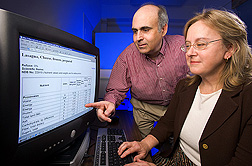Better Living Through In-Depth Food Analysis
More than 90 percent of folks in the United States get inadequate amounts of vitamin E from their diets, according to the Agricultural Research Service. We know this because surveyors query people about what they’ve eaten, and then other research nutritionists translate “foods eaten” into “nutrients consumed.”
But how do nutritionists calculate the individual vitamins and minerals people get based on a list of foods and drinks they reported having eaten?
It comes down to researchers who work hard at knowing just what’s in the foods, beverages, and dietary supplements people consume. The ARS Nutrient Data Laboratory (NDL) (www.ars.usda.gov/nutrientdata) develops specialized databases, available to the public, that provide nutrient information on both single- and multi-ingredient foods. The laboratory is located at the ARS Beltsville (Maryland) Human Nutrition Research Center.
At the heart of programs to determine a comprehensive suite of nutrients in U.S. foods and supplements is the National Food and Nutrient Analysis Program (NFNAP). “This year marks the 10th anniversary of this valuable partnership,” says NDL head Joanne Holden.
NDL researchers work under an interagency agreement with other groups within the Bethesda, Maryland-based National Institutes of Health (NIH). Through these collaborations, food-nutrient data is generated and updated on a regular basis.
“The data is used for a variety of national, regional, and local health-monitoring assessments, programs, and studies—as well as by the general public,” says NDL nutritionist David Haytowitz. He and nutritionist Pamela Pehrsson oversee the lab’s role in NFNAP.
A wide variety of food components are analyzed by commercial laboratories under contract with USDA and by cooperators at various universities. One of these is the USDA Jean Mayer Human Nutrition Research Center on Aging at Tufts University, in Boston, Massachusetts. Using food samples collected through NFNAP, the Vitamin K Laboratory there has been analyzing the amount of vitamin K in a variety of foods and providing that data for use in NDL’s compilations. (See "Vitamin K's Place in a Healthy Lifestyle" story on page 7 for information on the benefits of getting enough dietary vitamin K.)
One of NDL’s many new projects is an original Dietary Supplement Ingredients Database. Working with NIH’s Office of Dietary Supplements, the lab is developing the ingredients database as a complement to ARS’s National Nutrient Database for Standard Reference—a compilation of nutrients found in food products. The results of this work will eventually help nutritionists obtain more-accurate dietary survey results based not only on the foods people eat, but also on their dietary supplement intake.
“A key focus of the dietary supplement project is to verify—through laboratory analysis—the quantity of stated nutrients and other bioactive components in various dietary supplements,” says nutritionist Janet Roseland, who heads that project at NDL.
Other current projects include a database of the vitamin D content in certain foods, new and updated levels of trans fatty acids in a variety of foods, and new data on additional foods typically consumed by ethnic groups.—By Rosalie Marion Bliss, Agricultural Research Service Information Staff.
This research is part of Human Nutrition, an ARS national program (#107) described on the World Wide Web at www.nps.ars.usda.gov.
David B. Haytowitz is with the USDA-ARS Nutrient Data Laboratory, 10300 Baltimore Ave., Bldg. 005, Beltsville, MD 20705-2350; phone (301) 504-0714, fax (301) 504-0713.
"Better Living Through In-Depth Food Analysis" was published in the August 2007 issue of Agricultural Research magazine.







